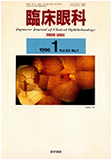Japanese
English
- 有料閲覧
- Abstract 文献概要
- 1ページ目 Look Inside
眼球位置覚の由来を明らかにするため,プルキニェ像による眼位測定法で,健常者6名について眼球圧迫試験による両眼球の挙動を調べた。①固視眼を鼻側へ圧迫しても固視眼に眼位変化はみられず,逆に遮閉した僚眼が平均5.2°内斜した。②遮閉眼を鼻側へ圧迫すると遮閉眼は平均4.2°内斜したが,僚眼には眼位変化はみられなかった。前者では,中枢神経からの運動命令が変化したため僚眼が内斜したと考えられるが,結果的にいずれの眼球を圧迫しても得られる眼位は変わらず,求心性信号は差がないと結論される。にもかかわらず前者でのみ視空間覚の偏位が得られることから,眼球位置覚が主に中枢神経系からの運動命令(遠心性コピー)に由来するとするBrigemanの主張が支持される。
We measured the eye position during eye compression tests in six normal persons using a dual Purkinje deviometer. When the monocularly fixating eye was pressed over the outer canthus, this eye deviated nasally but did not change its fixation. The occluded fellow eye deviated inwardly by an average of 5.2 degrees. When the occluded eye was pressed over the outer canthus, this eye alone deviated nasally by 4.2 degrees. In the first test, innervation from the central nervous system (CNS) appeared to have altered in maintaining the fixation. The perceptual shift of visual localization occurred only in the first test, even though the position of both eyes, which regulates inflow signal, was similar in both tests. These findings support the hypothesis by Brigeman that the registration of eye position mainly depends on the outflow signal through innervation from CNS.

Copyright © 1996, Igaku-Shoin Ltd. All rights reserved.


